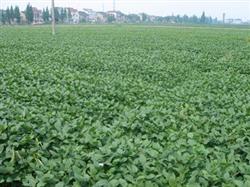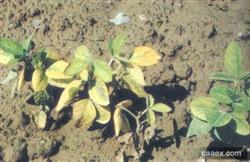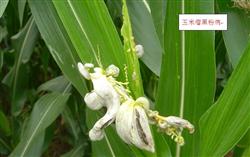Integrated Control of Three Pests on Spring Soybean

First, the ground tiger. The main pests that damage local crops are yellow tigers. The main results are as follows: 1. damage characteristics: the larvae mostly bite off the seedlings from the ground, resulting in missing seedlings and broken ridges. after the Lignification of the main stem, they feed on the root epidermis of the plant near the ground, causing root injury, affecting the root absorption of water, and causing the plant to wilt and die gradually. 2. Living habits: there are 2 generations a year. Generally, 4-6 instar larvae overwinter in soil layer 2-15 cm deep, most in 7-10 cm, mainly in 5-8 cm soil on the sunny side of field ridge and ditch embankment slope. The overwintering larvae begin to move in early March of the following spring, and pupate in the soil in the early and middle of April. The pupal period is 20-30 days. The damage was the most serious from May to June. Adults go out at night and have strong phototaxis and chemotaxis. Most of the eggs are scattered on the withered branches, fallen leaves, root stubbles and leaves 1-3 cm near the surface. Chenopodium, spinosa, and field twigs are the indicator plants for yellow tigers to feed and lay eggs. The damage of larvae is the heaviest after the 3rd instar. Spring and autumn do harm in two seasons of the year, but the damage is more serious in spring than in autumn. 3. ⑴ prediction of control measures: for the prediction of adults, moths can be trapped with black light or sweet and sour liquid, usually from the middle of April to the middle of May. The day with the largest amount of moths is the peak period, and the peak period of the 2nd-3rd instar larvae is pushed back 20-25 days, which is the suitable period for control. The method of field investigation is used for the prediction of larvae. If there are 0.5-1 larvae per square meter before or 0.1-0.3 larvae per square meter after fixing seedlings, the larvae should be controlled. A dry climate is conducive to a major occurrence. ⑵ agricultural control: ① selected stubble, the previous crop is not easy to select cornfield, should be inverted with wheat and rice rotation. ② irrigated in autumn and winter in time to eliminate the source of insects and remove weeds on the edge of the field in early spring. ⑶ trapping and killing control: ① black light traps and kills adults. ② sweet and sour solution was used to trap and kill adults. ⑷ chemical control: ① spray: the resistance of the 1st-3rd instar larvae is poor and exposed to host plants or the ground, which is the appropriate time for chemical control. It can be sprayed with 3000 times of 90% crystal trichlorfon, 50% phoxim EC, 1000-2000 times fenitrothion, 1000-1500 times chrysanthemum EC and 2.5% deltamethrin EC. ② poison bait: mostly used when feeding after 3 years old, using 2.5% trichlorfon powder 0.5kg or 90% crystal trichlorfon 1000 times solution per mu to evenly mix on chopped fresh grass, or 90% crystal trichlorfon with water 2.5kg-5kg, evenly mix on 50kg fried wheat bran or crushed cottonseed cake (oil dregs), 50g phoxim EC on 5kg cottonseed cake The poison bait is scattered into small piles at regular distances in the vegetable field in the evening. Second, alfalfa armyworm. A new pest broke out in our district in 2004, which is often mistaken for cabbage worm or cotton bollworm. The main results are as follows: 1. The characteristics of damage: the larvae are gluttonous and feed on leaves, resulting in a large lack of leaves, as well as flower buds and pods. 2. Living habits: in the north of China, there are two generations a year, overwintering as pupae in the soil. The first generation of adults Eclosion lays eggs in June every year, and the egg period is about 7 days. Damage to soybeans from mid-June to mid-July. The young larvae have the habit of spinning and rolling leaves and feed inside. When they grow up, they no longer roll the leaves and nibble away a large number of leaves. The first generation larvae entered the soil to build cocoons and pupated in July, and the adults emerged and laid eggs in August. The second generation larvae ate a large number of fruits such as pods besides leaves, causing serious damage. In September, the larvae matured into the soil to build cocoons and pupae to survive the winter. Adults need to feed on nectar to supplement nutrition and have phototaxis. The young larvae have the habit of running backward when they are frightened, and the older larvae bounce to the ground when they are disturbed. 3. Control methods: ⑴ uses black light and sweet-and-sour pot to trap and kill adults. ⑵ chemical control: before the 3rd instar, larvae were sprayed with broad-spectrum insecticides such as 21% EC 6000 times, 2.5% Kung Fu EC 5000 times, 2.5% Uranus EC 3000 times, and so on. 3. Red spider 1. damage characteristics: adult, juvenile and nymph mites feed on the silk on the back of the leaves, and the damaged bean leaves show yellow-white spots at the initial stage, and gradually become gray and white spots and red spots. In severe cases, the leaves curled, scorched and fell off, and the serious land was like a fire. The growth of the damaged bean plant is short, the pod is small, and the bean grain becomes smaller. 2. Living habits: female adult mites are generally clustered on withered leaves in bean fields, weed roots or soil cracks to survive the winter, and more than 10 generations occur every year. When the average temperature rises to 5-7 ℃ in spring, the overwintering female insects reproduce on weeds such as thistle, dandelion and plantain at first, then transfer to soybean from June to July. The damage is caused by silking and netting on the back of leaves. The peak period of damage is in late July and decreases in early August. If there is continuous high temperature and drought from June to July, it will propagate quickly and seriously. The optimum temperature is 29-30 ℃ and the optimum relative humidity is 35-55%. More Rain Water or increasing humidity in the soybean field is disadvantageous to the development of red spider eggs and adult and nymph mites, and can reduce the number. Extensive farming, many weeds or sparse growth occur in many fields, which often occur from the edge of the field, and then spread throughout the field. 3. ⑴ agricultural control methods: remove weeds and litter in land, roadside and fields, and cultivate the land to eliminate overwintering insect sources. Rational irrigation and fertilization can promote the robust growth of plants and enhance the ability of resistance to mites. ⑵ biological control: the important natural enemies of soybean red spiders are many kinds of lacewings, six-spot thrips, striped thrips and some ladybugs, bugs and spiders, which prey on red spiders in the field. ⑶ chemical control: strengthen the inspection of insect situation and control the occurrence stage of spot film. When yellow and white spots are found in the leaves of sporadic bean plants, spray immediately. You can choose 20% parathion EC, 20% diclofenac EC, 30% fenofol EC, 40% isocarbophos and so on diluted to 1000 times, spray 50 kg dilution per mu, 73% ketoprofen EC 1500 times dilution, 50 kg per mu. Pay attention to spray head up, spray up and down, spray evenly. According to the characteristics of high density and difficult spraying of soybean crops, "3911" 0.15kg sandy soil can be applied to field fumigation control.
- Prev

Determination and Control of Soybean "Fire Dragon Seedling"
Soybean cyst nematode disease is also called "fire dragon seedling" disease, which is caused by nematode parasitism on soybean roots. The root system of diseased plants is poorly developed, the lateral roots are significantly reduced, the growth is slow, the plants are short, the stems and leaves are yellow, the pods are not full, or the seeds are not set, and even the whole plant dies. Pulling up the diseased plants and observing, we can see that there are many needles on the fine roots...
- Next

Pay attention to the prevention and control of maize tumor smut
The symptoms of the disease can be infected in all parts of the ground during the whole growth period of corn, especially in the male-pumping stage. tumors of different sizes are produced in the affected part. at the initial stage, the tumor is wrapped in a white film, then turns gray, and then spreads black powder after cracking. that is, the spores of the pathogen. On the leaf easy to produce bean grain size tumor-like pile, male.
Related
- The first cup of black tea in spring, the flavor and history of tea gardens in Kenya, Africa
- The computer can not only choose potatoes, but also grow tea rice. AI will grow winter oolong tea champion.
- It is not only the inflated tea bitten by insects, but also engraved with the four seasons tea in Beipu.
- The Oriental Beauty Tea Festival in Zhuxian County takes the stage at the weekend to experience the plus-size feast of oil tea.
- & quot; Oriental Beauty Tea & Exploration of Emei in Hsinchu, the hometown of quot;
- The new variety of strawberry "Tainong 1" dessert is the first choice with mellow aroma. Crimson gorgeous
- History of Tea in Taiwan: from Wild Inner Mountain to Export Tea Garden
- Two types of Taiwan Oriental Beauty Black Tea won the British three-Star Award for Childhood Tea Xiang Zhang Jiaqi changed from pilot to champion tea maker.
- Banana species and varieties: the planting history of Taiwan Xianren banana and dwarf banana is long, is banana disease resistant?
- Coffee planting Technology: Qianjie Coffee from Seedling to harvesting

